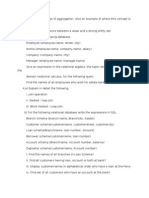0 ratings0% found this document useful (0 votes)
286 viewsBSCS Solution
BSCS Solution
Uploaded by
jifferentThis document contains the instructions and questions for a Database Management Systems midterm exam. It includes 6 multiple part questions testing various SQL skills like writing queries to retrieve information from several sample databases with different schemas. The questions cover topics like joins, aggregation, subqueries, and relational algebra.
Copyright:
© All Rights Reserved
Available Formats
Download as PDF, TXT or read online from Scribd
BSCS Solution
BSCS Solution
Uploaded by
jifferent0 ratings0% found this document useful (0 votes)
286 views5 pagesThis document contains the instructions and questions for a Database Management Systems midterm exam. It includes 6 multiple part questions testing various SQL skills like writing queries to retrieve information from several sample databases with different schemas. The questions cover topics like joins, aggregation, subqueries, and relational algebra.
Original Description:
BSCS Solution
Copyright
© © All Rights Reserved
Available Formats
PDF, TXT or read online from Scribd
Share this document
Did you find this document useful?
Is this content inappropriate?
This document contains the instructions and questions for a Database Management Systems midterm exam. It includes 6 multiple part questions testing various SQL skills like writing queries to retrieve information from several sample databases with different schemas. The questions cover topics like joins, aggregation, subqueries, and relational algebra.
Copyright:
© All Rights Reserved
Available Formats
Download as PDF, TXT or read online from Scribd
Download as pdf or txt
0 ratings0% found this document useful (0 votes)
286 views5 pagesBSCS Solution
BSCS Solution
Uploaded by
jifferentThis document contains the instructions and questions for a Database Management Systems midterm exam. It includes 6 multiple part questions testing various SQL skills like writing queries to retrieve information from several sample databases with different schemas. The questions cover topics like joins, aggregation, subqueries, and relational algebra.
Copyright:
© All Rights Reserved
Available Formats
Download as PDF, TXT or read online from Scribd
Download as pdf or txt
You are on page 1of 5
1
PUNJAB UNIVERSITY COLLEGE OF INFORMATION TECHNOLOGY
University of the Punjab
BS-CS Fall 2012
Mid Term Examination December 2012
Student ID:
Student Name:
Shift / Section: Morning / Afternoon
Student Signature:
Course Code: CMP-370 Course Title: Database Management System
Maximum Time: 90 Minutes Maximum Marks: 70
Instructions
Read questions carefully before solving.
Solve the questions on provided blank space under each question.
Understanding of the questions is part of examination. So, none of your queries will be
entertained in the examinations hall.
If there is any ambiguity in the paper, benefit will be given to the students.
Paper has 8 pages including title page.
Question # 1 2 3 4 5 6 Total
Total Marks 20 10 10 10 20 70
Marks
Obtained
Examiner Signature: Marks Out of 35:
DO NOT OPEN UNTIL YOU ARE TOLD TO DO SO
Sheet No.:
Invigilator Sign:
Date:
2
Question 1: (Marks 20)
The boat reservations database has the following schema:
sailor: sname (string), rating (integer)
boat: bname (string), color (string), rating (integer)
reservation: sname (string), bname (string), weekday (string)
The rating attribute for boats indicates the minimum rating required of a sailor reserving the boat. In addition, the
following hold:
sname is the primary key of sailor (so every sailor has just one rating);
bname is the primary key of boat (so every boat has just one color and one rating);
bname is a foreign key in the reservation relation, referencing relation boat (so every bname in
reservation occurs in boat, but the converse need not be true)
sname is a foreign key in the reservation relation, referencing relation sailor (so every sname in
reservation occurs in sailor, but the converse need not be true)
Here is one example instance given in Figure 1 over the above schema:
Figure 1: Database instance for Question 1
Write the following queries in SQL (of course, the queries must work on all data, not just the sample one):
a) (3 points) List all boats reserved on Wednesday and their color.
select distinct reservation.bname, color from reservation, boat
where reservation.bname = boat.bname and reservation.weekday = Wednesday
b) (3 points) List all pairs of sailors who have reserved boats on the same day.
select distinct x.sname, y.sname from reservation x, reservation y
where x.weekday = y.weekday
3
c) (5 points) List the days appearing in the reservation relation for which only red boats are reserved.
select distinct weekday from reservation
where weekday not in
(select r.weekday from reservation r, boat b
where r.bname = b.bname and b.color < > red)
d) (4 points) For each day, list the number of red boats reserved on that day.
select r.weekday, count(distinct r.bname) as number from reservation r, boat b
where r.bname = b.bname and b.color = red
group by weekday
e) (5 points) For each day of the week occurring in the reservation relation, list the average rating of sailors
having reserved boats that day.
select weekday, avg(rating) from sailor, reservation
where sailor.sname = reservation.sname
group by weekday
Question 2: (Marks 10)
Consider the following relations:
Emp(eno, ename, title, city)
Proj(pno, pname, budget, city)
Works(eno, pno, resp, dur)
Pay(title, salary)
where the primary keys are underlined, and Emp.title is a foreign key to Pay.title, Works.eno is a foreign key to Emp.eno,
and Works.pno is a foreign key to Proj.pno.
For each part of this question (considered independently of the other parts), write a single SQL statement that
accomplishes the given requirements.
a) (3 points) For each city, how many projects are located in that city and what is the total budget over all projects in
the city?
SELECT city , count (pno) AS totproj , sum ( budget ) AS totbudget
FROM Proj
GROUP BY city
b) (3 points) List all projects located in Lahore and include for each one the number of persons working on the
project.
4
SELECT Proj.pno , count (* ) FROM Proj LEFT OUTER JOIN Works ON ( Proj.pno=Works.pno )
WHERE city=`Lahore `
GROUP BY Proj.pno , pname
c) (4 points) Formulate the following SQL query in relational algebra. This is expressed over the same schema as
above.
SELECT pname , budget
FROM Proj , Works , Emp
WHERE title =`Programmer `
AND Works.eno = Emp.eno
AND Works.pno = Proj.pno
*pname,budget (Proj ./ Works ./ (-- title=`Programmer' Emp))
You can put the selection outside all of the joins if you wish; that would work too:
*pname,budget (--title=`Programmer'(Proj ./ Works ./ Emp))
Question 3: (Marks 10)
Consider the instance of the Sailors relation given in Figure 2 where the key is underlined. Show the results of the
following query.
Figure 2: Database instance for Question 3
a) (5 points)
SELECT S.sid
FROM Sailors S
WHERE S.rating >= ALL
(SELECT S2.rating
FROM Sailors S2 )
Note: The result that is returned is a table. You need to specify the column title.
Sid
58
71
b) (5 points)
5
SELECT S.rating , AVG( S.age ) AS average
FROM Sailors S
GROUP BY S.rating
HAVING 1 <
(SELECT COUNT(*)
FROM SAILORS S2
WHERE S.rating = S2.rating )
Note: The result that is returned is a table. You need to specify the column title.
Rating | average
3 44.5
7 40
8 40.5
10 25.5
.:. ____________________________ .:.
Question 4: (Marks 10)
Consider the database consisting of one relation:
movie: title, director, actor.
Express the following queries in SQL.
a) (5 points) List the actors cast only in movies by Berto.
select actor from movie
where actor not in
(select actor from movie
where director ! = Berto )
b) (5 points) List all pairs of distinct actors who act together in at least one movie.
select m1.actor as actor1, m2.actor as actor2
from movie m1, movie m2
where m1.title = m2.title
You might also like
- DCP L8410CDW, MFC L8610CDW, MFC L8690CDW, MFC L8900CDW, MFC L9570CDW PDFDocument37 pagesDCP L8410CDW, MFC L8610CDW, MFC L8690CDW, MFC L8900CDW, MFC L9570CDW PDFStefanGarnetNo ratings yet
- Nuage Networks VNS Fundamentals Student Guide v1.0 PDFDocument280 pagesNuage Networks VNS Fundamentals Student Guide v1.0 PDFkalwar98es100% (3)
- SDK TC-Python Quick Install GuideDocument7 pagesSDK TC-Python Quick Install Guideankit soniNo ratings yet
- Please Write Your Roll NoDocument3 pagesPlease Write Your Roll NosheetaljaluthriasNo ratings yet
- IDBMS (Y21) ETsolDocument6 pagesIDBMS (Y21) ETsolrahul harpalNo ratings yet
- Comph SQL (G9)Document28 pagesComph SQL (G9)gjajNo ratings yet
- Cse373 09sp Midterm1.KeyDocument10 pagesCse373 09sp Midterm1.KeyLe HuyNo ratings yet
- 4CSPL2011 - Web - Development - Using - Python - Django Question BankDocument9 pages4CSPL2011 - Web - Development - Using - Python - Django Question Bankanilvs2004No ratings yet
- Sample FinalDocument8 pagesSample Finalshravanmadhu45No ratings yet
- CSC 108H1 F 2010 Test 1 Duration - 45 Minutes Aids Allowed: NoneDocument8 pagesCSC 108H1 F 2010 Test 1 Duration - 45 Minutes Aids Allowed: NoneexamkillerNo ratings yet
- Cisc 630 - HW2 PDFDocument2 pagesCisc 630 - HW2 PDFUSVet96No ratings yet
- Bcs Higher Education Qualifications BCS Level 5 Diploma in ITDocument11 pagesBcs Higher Education Qualifications BCS Level 5 Diploma in ITOzioma IhekwoabaNo ratings yet
- HW 1Document5 pagesHW 1postscriptNo ratings yet
- SQL IvDocument14 pagesSQL IvKrishnendu RarhiNo ratings yet
- InfyTQ Daily Test Questions On 19th Feb 2020Document14 pagesInfyTQ Daily Test Questions On 19th Feb 2020Phani PNo ratings yet
- Assignment 2 DBMSDocument6 pagesAssignment 2 DBMSMathematically DistrubNo ratings yet
- MzL5phDL12906Document6 pagesMzL5phDL12906abhinavraghav991No ratings yet
- CSIT2040 - Database SystemsDocument5 pagesCSIT2040 - Database Systemsms21900518No ratings yet
- Dbms QuestionsDocument8 pagesDbms QuestionsATHARVA DOIFODENo ratings yet
- 3SFE618 Formal Methods 2007Document17 pages3SFE618 Formal Methods 2007Hasini PereraNo ratings yet
- Exam 04Document29 pagesExam 04George MSenoirNo ratings yet
- Assignment - IDocument5 pagesAssignment - Ijyothibellary2754No ratings yet
- DBMS AssignmentDocument2 pagesDBMS AssignmentSagar AryanNo ratings yet
- CS3481 SET 2Document5 pagesCS3481 SET 2Benitta MaryNo ratings yet
- 2017A FE AM QuestionDocument30 pages2017A FE AM QuestionShah AlamNo ratings yet
- COMS4111 Spring 2014Document8 pagesCOMS4111 Spring 2014arpegekplNo ratings yet
- 19Cs2108S - Database Management Systems: Time: Max - Marks: 100Document4 pages19Cs2108S - Database Management Systems: Time: Max - Marks: 100vamsi krishna mNo ratings yet
- ISC 2005 Computer Science Paper 1 TheoryDocument6 pagesISC 2005 Computer Science Paper 1 TheoryShadowerNo ratings yet
- Final - I DBMS - 2014 - B.TECHDocument2 pagesFinal - I DBMS - 2014 - B.TECHYash BhatnagarNo ratings yet
- April2007 FE PM Questions Ver1Document58 pagesApril2007 FE PM Questions Ver1VuDucHuyNo ratings yet
- CSC108 Final 2012FDocument22 pagesCSC108 Final 2012FexamkillerNo ratings yet
- Computer Science XII ISC Sample PaperDocument9 pagesComputer Science XII ISC Sample PaperAkshay PandeyNo ratings yet
- Assignment DBDA PreetiDocument12 pagesAssignment DBDA PreetimounikaNo ratings yet
- Assignment 3 NPTEL DBMS January 2024Document10 pagesAssignment 3 NPTEL DBMS January 2024no.reply15203No ratings yet
- Apsc 160 (Ubc)Document10 pagesApsc 160 (Ubc)JFOXX7777No ratings yet
- Higher Data Structures and Algorithms This Is A Sample Only Time Allowed: 3 Hours Total Marks: 100 Number of Parts: 5Document9 pagesHigher Data Structures and Algorithms This Is A Sample Only Time Allowed: 3 Hours Total Marks: 100 Number of Parts: 5BilboBagginsesNo ratings yet
- MzL5phDL11246Document5 pagesMzL5phDL11246abhinavraghav991No ratings yet
- GATE - Ques Set 3Document18 pagesGATE - Ques Set 3rahulyadavsingaporeNo ratings yet
- Requirments de enDocument21 pagesRequirments de enV BarNo ratings yet
- Assignment DBMSDocument6 pagesAssignment DBMSshashi03kNo ratings yet
- 1252706787xii B Cs Practical List 2018-19 PDFDocument6 pages1252706787xii B Cs Practical List 2018-19 PDFPartapsingh CheemaNo ratings yet
- Python Solutions For IPA Jan 29thDocument14 pagesPython Solutions For IPA Jan 29thYogesh SharmaNo ratings yet
- Exam II 2013 - SolutionDocument10 pagesExam II 2013 - Solutionsuperman136No ratings yet
- PUT Sol KMBN206 2023-24Document12 pagesPUT Sol KMBN206 2023-24harshk23-mbaNo ratings yet
- 15ECSC701 - 576 - KLE47-15Ecsc701-set1 Cse PaperDocument5 pages15ECSC701 - 576 - KLE47-15Ecsc701-set1 Cse PaperAniket AmbekarNo ratings yet
- DBMS 2022-23 MidsemDocument9 pagesDBMS 2022-23 MidsemPrateek TalwarNo ratings yet
- Assignment 2 KeyDocument6 pagesAssignment 2 KeykrishnanandNo ratings yet
- DBMS 18CSL58 Lab Manual - BkitDocument112 pagesDBMS 18CSL58 Lab Manual - BkitMohd Mushtaq TalikotiNo ratings yet
- Exam 2019s1Document37 pagesExam 2019s1paper FeymanNo ratings yet
- Assignment 3Document11 pagesAssignment 3Shivam GaikwadNo ratings yet
- S.S.S. SAMITI's S.A.M. D. Higher Secondary School of ScienceDocument5 pagesS.S.S. SAMITI's S.A.M. D. Higher Secondary School of ScienceSUPRIYA BHAGATNo ratings yet
- MzL5phDL11436Document4 pagesMzL5phDL11436abhinavraghav991No ratings yet
- 3SFE618 Formal Methods 2009Document18 pages3SFE618 Formal Methods 2009Hasini PereraNo ratings yet
- DBMS Lab - McaDocument6 pagesDBMS Lab - McaS.R NainNo ratings yet
- DBMSDocument10 pagesDBMSShivendraKaushikNo ratings yet
- Test1 v1Document8 pagesTest1 v1hadifabakhtiarNo ratings yet
- BCS The Chartered Institute For IT The Bcs Profesional Examinations BCS Level 4 Certificate in ITDocument5 pagesBCS The Chartered Institute For IT The Bcs Profesional Examinations BCS Level 4 Certificate in ITJessica TiffanyNo ratings yet
- CS Preboard Paper SET-5Document15 pagesCS Preboard Paper SET-5Bhawesh Kumar Soni100% (1)
- DeThiGiuaKy in TiengAnhDocument14 pagesDeThiGiuaKy in TiengAnhSơn ĐặngNo ratings yet
- Programming Paradigms - C++ FS 2017: Universit at BaselDocument4 pagesProgramming Paradigms - C++ FS 2017: Universit at BaselBookDown100% (1)
- CMPT-354 D1 Fall 2008 Instructor: Martin Ester TA: Gustavo Frigo Final Exam With SolutionDocument7 pagesCMPT-354 D1 Fall 2008 Instructor: Martin Ester TA: Gustavo Frigo Final Exam With SolutionlcoNo ratings yet
- CSCA08 Mid 2012FDocument8 pagesCSCA08 Mid 2012FexamkillerNo ratings yet
- How To Use HootsuiteDocument147 pagesHow To Use HootsuiteAna Lyn MercaderNo ratings yet
- B2-Beat-Lte-D7225 - Eng Chiperase Download Guide - 0 1Document18 pagesB2-Beat-Lte-D7225 - Eng Chiperase Download Guide - 0 1Herwin Peralta GutierrezNo ratings yet
- Computational Statistical Physics Exercise Sheet 5: V H J I 1 N N Ij J IDocument5 pagesComputational Statistical Physics Exercise Sheet 5: V H J I 1 N N Ij J IParide AzzariNo ratings yet
- New Pay SpineDocument2 pagesNew Pay Spineapi-270080997No ratings yet
- Methods For Ordinary Differential Equations: 5.1 Initial-Value ProblemsDocument20 pagesMethods For Ordinary Differential Equations: 5.1 Initial-Value ProblemsPatricia Calvo PérezNo ratings yet
- Big O-Little o BESTDocument8 pagesBig O-Little o BESTLEONCIO IBARRANo ratings yet
- Vi Editor CommandsDocument10 pagesVi Editor Commandsabdhana0% (1)
- Website Search Engine Optimization ProposalDocument6 pagesWebsite Search Engine Optimization ProposalI Gusti Oka PrinarjayaNo ratings yet
- Markov Chains PDFDocument66 pagesMarkov Chains PDFVishnuvardhanNo ratings yet
- Brain Tumour Detection Using M-IRO-Journals-3 4 5Document12 pagesBrain Tumour Detection Using M-IRO-Journals-3 4 5MR. AJAYNo ratings yet
- NMDC Limited: How To Fill The Online Application FormDocument3 pagesNMDC Limited: How To Fill The Online Application FormArunNo ratings yet
- Ooad NotesDocument25 pagesOoad NotesLakshay GuptaNo ratings yet
- EDIMAX IPCamera CGI For 3005 3030 7010Document34 pagesEDIMAX IPCamera CGI For 3005 3030 7010didadu999No ratings yet
- ReverseDocument29 pagesReverseMehul ShindeNo ratings yet
- Middleware MonitoringDocument101 pagesMiddleware MonitoringSuresh ReddyNo ratings yet
- 41 PRODUCTION LINES Preguntas Cap1 Parte 1Document4 pages41 PRODUCTION LINES Preguntas Cap1 Parte 1HysteriDanRoadzNo ratings yet
- Figure 7-11 Inter-VLAN Routing Example1Document10 pagesFigure 7-11 Inter-VLAN Routing Example1GoodsonNo ratings yet
- Fabric Path Config GuideDocument94 pagesFabric Path Config GuideVince PerrineNo ratings yet
- Curriculum VitaeDocument2 pagesCurriculum VitaecozyboyzNo ratings yet
- Design & Implementation of Mamdani Fuzzy Inference System On An Automatic Train Braking SystemDocument5 pagesDesign & Implementation of Mamdani Fuzzy Inference System On An Automatic Train Braking SystemijsretNo ratings yet
- CBTCDocument5 pagesCBTCyadvikram7No ratings yet
- PineApp OSG Anti-Spam Engines & ValuesDocument7 pagesPineApp OSG Anti-Spam Engines & Valuesfinaltoheaven1No ratings yet
- Leonardo Roars For Your Attention-Fedora 11 ReviewedDocument116 pagesLeonardo Roars For Your Attention-Fedora 11 ReviewedSanthosh Mahankali100% (1)
- Outlook Search CriteriaDocument8 pagesOutlook Search CriteriaNett2kNo ratings yet
- Celeste RegueroDocument30 pagesCeleste RegueroGary Evangelista100% (1)
- ItilDocument79 pagesItilAbhijit SahaNo ratings yet
- Workera ReportDocument22 pagesWorkera ReportJITENDRA PATELNo ratings yet

























































































